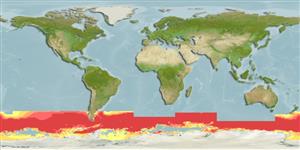Actinopterygii (ray-finned fishes) >
Perciformes (Perch-likes) >
Nototheniidae (Cod icefishes)
Etymology: Paranotothenia: Greek, para = near + Greek, noton = back + Greek, adverbial particle, then, that denotes distance or removal (Ref. 45335); magellanica: magellanica for the straits of Magellan, the type locality (Ref. 11892).
Environment / Climate / Range
Ecology
Marine; pelagic-oceanic; depth range 0 - 255 m (Ref. 11892), usually 0 - 20 m (Ref. 11892). Temperate, preferred ?; 43°S - 78°S
Southern Ocean: southern tip of South America. Also found in Falkland, South Georgia, South Orkney, South Shetland, Prince Edward, Crozet, Kerguelen, Heard and Macquarie islands, southern New Zealand and associated islands, rarely in the Ross Sea. New Zealand and Argentina (Patagonia) (Ref. 4537)
Size / Weight / Age
Maturity: Lm ? range ? - ? cm
Max length : 38.0 cm SL male/unsexed; (Ref. 5179)
Dorsal
spines
(total): 3 - 6;
Dorsal
soft rays
(total): 28-31;
Anal
soft rays: 22 - 25. Greyish olive above, yellowish below. Pug-nosed snout, well developed supraoccipital crest, highly sculptured cranial bones. Short jaw, the maxillary not reaching the orbit, and adults with pelagic coloration as well as large epurals (Ref. 11892). Upper lateral line with 36-48 tubular scales, total number of scales in upper and middle lateral lines 45-57; caudal peduncle longer than deep, 37.0-45.5% HL; preoperculo-mandibular canal not connected with the temporal canal; dorsal surface of head without prominent ridges; pelvic length much shorter than pectorals (Ref. 37311).
Utilized as a food fish.
Dewitt, H.H., P.C. Heemstra and O. Gon, 1990. Nototheniidae. p. 279-331. In O. Gon and P.C. Heemstra (eds.) Fishes of the Southern Ocean. J.L.B. Smith Institute of Ichthyology, Grahamstown, South Africa. (Ref. 5179)
IUCN Red List Status (Ref. 115185)
CITES (Ref. 94142)
Not Evaluated
Threat to humans
Harmless
Human uses
Fisheries: commercial
More information
ReferencesAquacultureAquaculture profileStrainsGeneticsAllele frequenciesHeritabilityDiseasesProcessingMass conversion
Tools
Special reports
Download XML
Internet sources
Estimates of some properties based on models
Phylogenetic diversity index (Ref.
82805): PD
50 = 0.7500 [Uniqueness, from 0.5 = low to 2.0 = high].
Bayesian length-weight: a=0.00631 (0.00294 - 0.01353), b=3.19 (3.01 - 3.37), in cm Total Length, based on LWR estimates for this (Sub)family-body shape (Ref.
93245).
Trophic Level (Ref.
69278): 3.4 ±0.4 se; Based on size and trophs of closest relatives
Resilience (Ref.
69278): Medium, minimum population doubling time 1.4 - 4.4 years (K=0.26; Fec > 10,000).
Vulnerability (Ref.
59153): Moderate vulnerability (41 of 100) .
